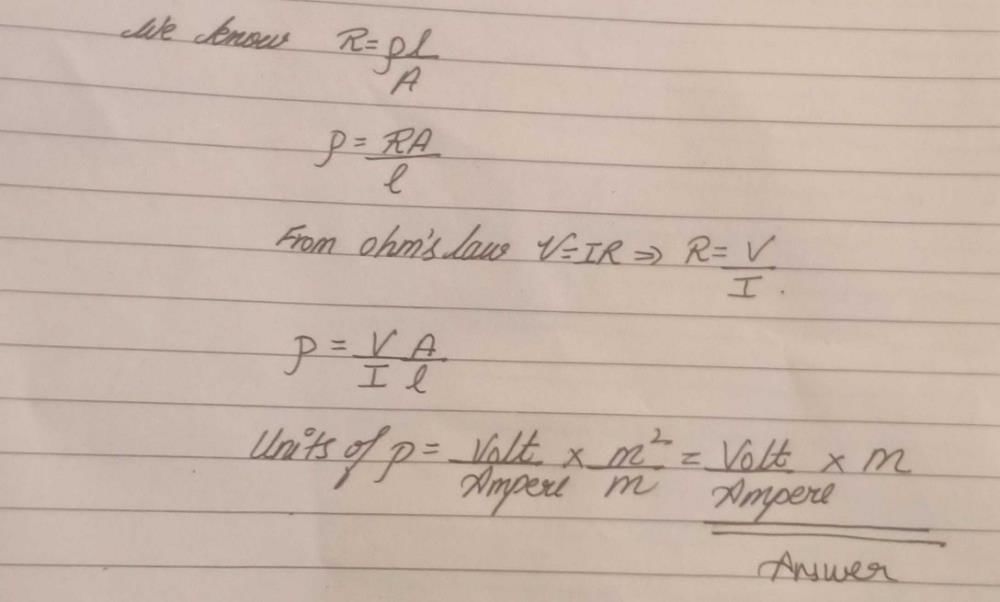Class 12 Exam > Class 12 Questions > Unit of Resistivity isa)meter ×Ampere/Voltb)V...
Start Learning for Free
Unit of Resistivity is
a)meter ×Ampere/Volt
b)Volt ×Ampere/meter
c)Volt ×Ampere
d)Volt meter/Ampere
Correct answer is option 'D'. Can you explain this answer?
Verified Answer
Unit of Resistivity isa)meter ×Ampere/Voltb)Volt ×Ampere/meterc)Volt ×...
Most Upvoted Answer
Unit of Resistivity isa)meter ×Ampere/Voltb)Volt ×Ampere/meterc)Volt ×...

Free Test
FREE
| Start Free Test |
Community Answer
Unit of Resistivity isa)meter ×Ampere/Voltb)Volt ×Ampere/meterc)Volt ×...
Resistivity is a fundamental property of a material that determines how strongly it resists the flow of electric current. It is denoted by the Greek letter rho (ρ) and is measured in units of ohm meter (Ω·m). The resistivity of a material is an intrinsic property, meaning it does not depend on the dimensions or shape of the material.
The resistivity of a material can be calculated using the formula:
Resistivity (ρ) = Resistance (R) × Cross-sectional area (A) / Length (L)
Where R is the resistance of the material, A is the cross-sectional area through which the current is flowing, and L is the length of the material.
Explanation of the options:
a) meter × Ampere/Volt: This unit represents the dimensions of length multiplied by current divided by voltage, which is not the correct unit for resistivity.
b) Volt × Ampere/meter: This unit represents the dimensions of voltage multiplied by current divided by length, which is also not the correct unit for resistivity.
c) Volt × Ampere: This unit represents the dimensions of voltage multiplied by current, which is the unit for electrical power, not resistivity.
d) Volt meter/Ampere: This unit represents the dimensions of voltage multiplied by length divided by current, which is the correct unit for resistivity.
In summary, the correct unit of resistivity is Volt meter/Ampere, which represents the dimensions of voltage multiplied by length divided by current. This unit is derived from the formula for resistivity and reflects the intrinsic property of a material to resist the flow of electric current.
The resistivity of a material can be calculated using the formula:
Resistivity (ρ) = Resistance (R) × Cross-sectional area (A) / Length (L)
Where R is the resistance of the material, A is the cross-sectional area through which the current is flowing, and L is the length of the material.
Explanation of the options:
a) meter × Ampere/Volt: This unit represents the dimensions of length multiplied by current divided by voltage, which is not the correct unit for resistivity.
b) Volt × Ampere/meter: This unit represents the dimensions of voltage multiplied by current divided by length, which is also not the correct unit for resistivity.
c) Volt × Ampere: This unit represents the dimensions of voltage multiplied by current, which is the unit for electrical power, not resistivity.
d) Volt meter/Ampere: This unit represents the dimensions of voltage multiplied by length divided by current, which is the correct unit for resistivity.
In summary, the correct unit of resistivity is Volt meter/Ampere, which represents the dimensions of voltage multiplied by length divided by current. This unit is derived from the formula for resistivity and reflects the intrinsic property of a material to resist the flow of electric current.

|
Explore Courses for Class 12 exam
|

|
Similar Class 12 Doubts
Unit of Resistivity isa)meter ×Ampere/Voltb)Volt ×Ampere/meterc)Volt ×Ampered)Volt meter/AmpereCorrect answer is option 'D'. Can you explain this answer?
Question Description
Unit of Resistivity isa)meter ×Ampere/Voltb)Volt ×Ampere/meterc)Volt ×Ampered)Volt meter/AmpereCorrect answer is option 'D'. Can you explain this answer? for Class 12 2025 is part of Class 12 preparation. The Question and answers have been prepared according to the Class 12 exam syllabus. Information about Unit of Resistivity isa)meter ×Ampere/Voltb)Volt ×Ampere/meterc)Volt ×Ampered)Volt meter/AmpereCorrect answer is option 'D'. Can you explain this answer? covers all topics & solutions for Class 12 2025 Exam. Find important definitions, questions, meanings, examples, exercises and tests below for Unit of Resistivity isa)meter ×Ampere/Voltb)Volt ×Ampere/meterc)Volt ×Ampered)Volt meter/AmpereCorrect answer is option 'D'. Can you explain this answer?.
Unit of Resistivity isa)meter ×Ampere/Voltb)Volt ×Ampere/meterc)Volt ×Ampered)Volt meter/AmpereCorrect answer is option 'D'. Can you explain this answer? for Class 12 2025 is part of Class 12 preparation. The Question and answers have been prepared according to the Class 12 exam syllabus. Information about Unit of Resistivity isa)meter ×Ampere/Voltb)Volt ×Ampere/meterc)Volt ×Ampered)Volt meter/AmpereCorrect answer is option 'D'. Can you explain this answer? covers all topics & solutions for Class 12 2025 Exam. Find important definitions, questions, meanings, examples, exercises and tests below for Unit of Resistivity isa)meter ×Ampere/Voltb)Volt ×Ampere/meterc)Volt ×Ampered)Volt meter/AmpereCorrect answer is option 'D'. Can you explain this answer?.
Solutions for Unit of Resistivity isa)meter ×Ampere/Voltb)Volt ×Ampere/meterc)Volt ×Ampered)Volt meter/AmpereCorrect answer is option 'D'. Can you explain this answer? in English & in Hindi are available as part of our courses for Class 12.
Download more important topics, notes, lectures and mock test series for Class 12 Exam by signing up for free.
Here you can find the meaning of Unit of Resistivity isa)meter ×Ampere/Voltb)Volt ×Ampere/meterc)Volt ×Ampered)Volt meter/AmpereCorrect answer is option 'D'. Can you explain this answer? defined & explained in the simplest way possible. Besides giving the explanation of
Unit of Resistivity isa)meter ×Ampere/Voltb)Volt ×Ampere/meterc)Volt ×Ampered)Volt meter/AmpereCorrect answer is option 'D'. Can you explain this answer?, a detailed solution for Unit of Resistivity isa)meter ×Ampere/Voltb)Volt ×Ampere/meterc)Volt ×Ampered)Volt meter/AmpereCorrect answer is option 'D'. Can you explain this answer? has been provided alongside types of Unit of Resistivity isa)meter ×Ampere/Voltb)Volt ×Ampere/meterc)Volt ×Ampered)Volt meter/AmpereCorrect answer is option 'D'. Can you explain this answer? theory, EduRev gives you an
ample number of questions to practice Unit of Resistivity isa)meter ×Ampere/Voltb)Volt ×Ampere/meterc)Volt ×Ampered)Volt meter/AmpereCorrect answer is option 'D'. Can you explain this answer? tests, examples and also practice Class 12 tests.

|
Explore Courses for Class 12 exam
|

|
Signup for Free!
Signup to see your scores go up within 7 days! Learn & Practice with 1000+ FREE Notes, Videos & Tests.





















